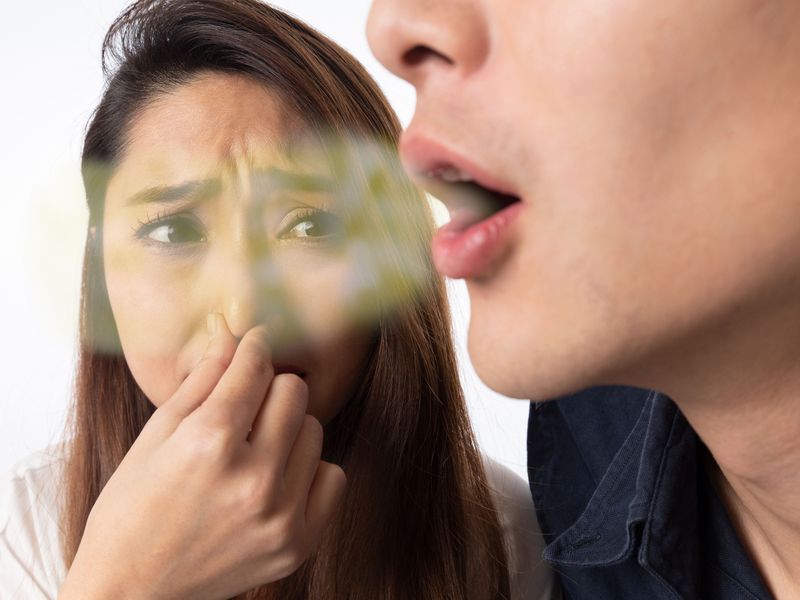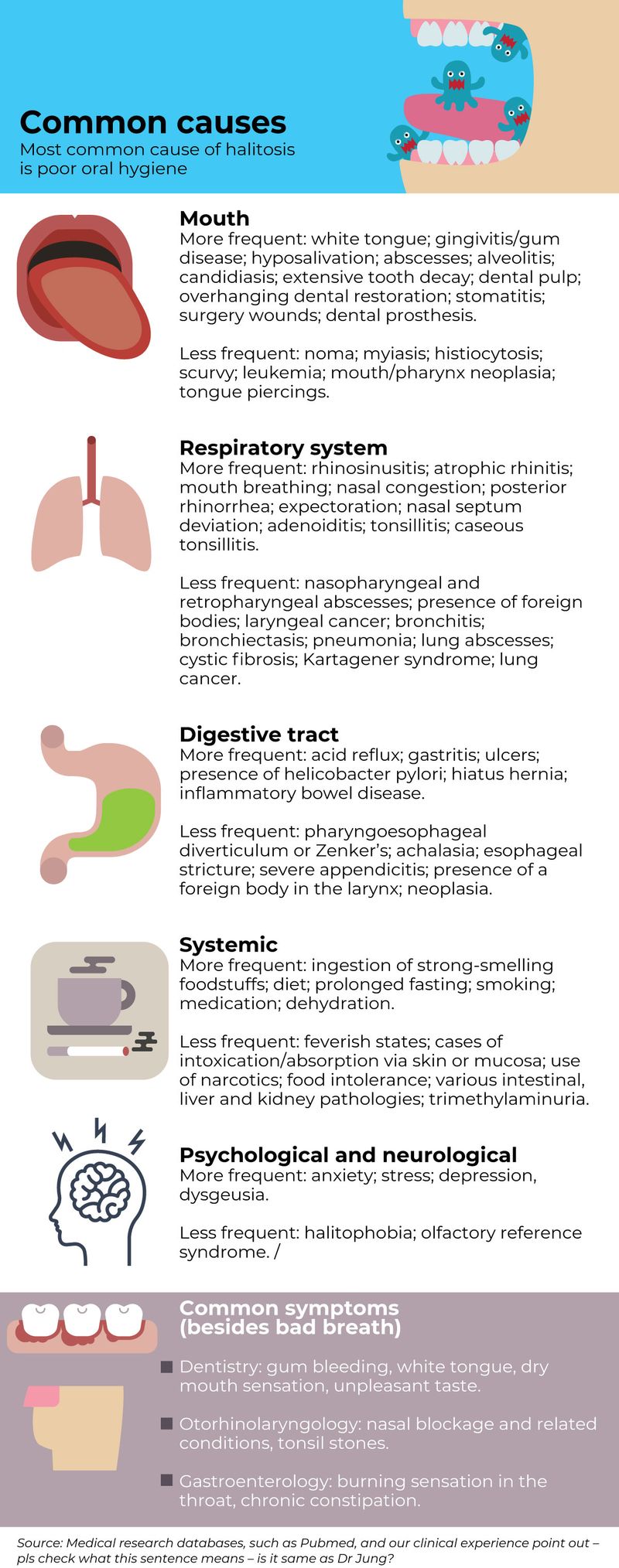
Dubai: Halitosis or bad breath that people often think is limited to oral or dental hygiene actually has a cause that lies much deeper and is linked to recurrent sinus infections, acid reflux, poor eating habits, some disruption in gut microbiome or — in case of children — is caused due to swollen adenoids and tonsillitis.
To date, more than 3,000 different volatile compounds (gases) have been detected in multiple people’s breath. Individually, a sample of exhaled air usually contains more than 200 different compounds. Factors that influence the composition of human breath include physical condition, diseases, general state of health, the intake of certain foods and medicines, environmental factors and lifestyle. Halitosis can be brought on by more than 80 physiopathologies or causes. Therefore, bad breath is an indicator of abnormal bacterial activity or a disturbance in the physiological mechanism.
Gulf News spoke to doctors to understand the genesis of this problem. Dr Jonas Nunes, specialist on Breath Research at the Institute del Alien to, Barcelona, who is all set to open a special Halitosis clinic at a leading Dubai hospital this month, and Dr Prashant Sharma, specialist ENT at Prime Hospital, and Dr Hwoon-Yong Jung, Specialist, Gastroenterological, Esophageal and Gastric diseases, Therapeutic Endoscopy, Asan Medical Centre, South Korea, which is to open the first gastroenterology hospital in UAE and the GCC, and Dr Murat Guzel , a dentist and specialist implantologist at Dental Studio, Dubai, shared their views on the subject with Gulf News.
What is Halitosis?
Halitosis is an unpleasant smell of the exhaled air (either from the mouth or from the nose). The main reason behind bad breath involves infections of the oesophagus, nose and poor hygiene of the oral cavities that result in recurrent infections and bacterial growth, giving rise to halitosis.
Who is at risk?
Anyone in the age-group of 2-95 years is at risk of developing halitosis, with the average age being 39 years. Dr Nunes said: “Halitosis has a high prevalence and can affect people of any gender, age, race and socioeconomic status. Scientific publications estimate that more than 25 per cent of the world population suffers from this problem regularly. However, owing to a personal sense of shame and social taboo around the topic, many people tend to gloss over it or prefer not to approach the problem scientifically.”

Halitosis among children
According to Dr Sharma, children often suffer from halitosis owing to swollen tonsils and adenoids. “Children with swollen adenoids often have blocked noses and breathe through the mouth, resulting in a bio-film of bacteria attached to the surface of the glands, causing frequent infections. The bacteria results in frequent throat infections, causing mucous and bad breath and the issue can be resolved only once the adenoids are surgically removed.”
Dr Nunes added: “In case of children, other underlying pathologies such as lactose intolerance, indigestion could also be reasons for bad breath.”
The sinus connection
People who get frequent sinusitis and suffer from allergic rhinitis and other respiratory infections are also highly susceptible to halitosis. Dr Sharma explained: “When people suffer from chronic sinus infections, there is a build- up of mucous. When a person exhales, the temperature of the breath is nearly 36-37 degrees Celsius and humidity is nearly 96-97 per cent, which triggers bacterial growth and bad breath. Many people with blocked noses breathe from their mouths causing Xerostomia (saliva reduction or dry mouth), which again triggers more bacterial growth and bad breath.”
Do women suffer from halitosis more than men?
According to Dr Nunes, that is not the case. However, women who are sensitive about bad breath usually turn up for treatment. He said: “At the Breath Institute, that I lead in Harley Street, London, we have nearly 53 per cent of female patients, as opposed to 43 per cent males, indicating that women are more likely to be conscious of bad breath and also more likely than men to resort to a consultation. Women also tend to be more anxious and worry more about their own breath, regarding it more negatively than men do. Likewise, mothers are more likely than fathers to worry about their children’s halitosis.”
Halitosis impacts most negatively the quality of life in the 15-35 age group, when its social effects become more evident, with patients showing signs of low self-esteem, insecurity and isolation, as well as repercussions on relationships with their partner and friends, and academic underperformance. From the age of 35 onwards, more importance is assigned to the professional context, which causes patients to come to the clinic for fear that halitosis will have a negative impact on their career.
Poor oral hygiene is one of the chief reasons of halitosis
The mouth is the gateway from the surrounding world into our body. Bad breath can repel people and result in isolation. Dr Guzel elaborated: “Our food habits affect our mouth and body. Proper oral hygiene, regular dental check-ups and being mindful of the food and beverages that we consume are important for our oral and general health. Physically, halitosis can be caused by diseases in the mouth or the gastro-intestinal canal (stomach and guts). The mouth is the primary reason for “bad breath” — specifically if the person has poor oral hygiene.”
Food and bacteria accumulate naturally in the mouth and if not sufficiently removed it will produce foul gases that we perceive as foul odour. Furthermore, decay of hard and soft tissue due to tooth decay and gum and bone diseases can also cause bad breath said Dr Guzel.
Other reasons for bad breath can be dehydration, smoking, excessive alcohol consumption and diseases of the gastro-intestinal tract.

Poor dental hygiene can also cause accumulation of debris and bad breath. For example, bulky veneers that accumulate bacteria along the margin of the veneer can cause decay and infection of the gums.
Dr Guzel concluded: “It is my recommendation that patients begin to look at the mouth as a mirror of their general health. We need to educate our health-care professionals and patients on a holistic approach to oral and general health. It is important to understand that the habits that cause diseases in the mouth also cause disease further down the system. If your bad diet or poor oral hygiene is causing decay in the strongest material in the body (the teeth), then it’s most likely also causing damage to the rest of your body.”
Is bad breath linked to gut health?
Dr Yong Jung explained: “Poor Gut microbiome is one of the reasons that bad bacteria multiply, infiltrating the GI tract. Oral microbiota, a part of gut microbiome, colonises the mouth and nasal cavity and produces malodorous material. The mouth is the reservoir site of microbes, nutrients and enzymes passing to gut.
Dr Guzel illustrated how poor choice of food often cause high acid buildup and bad breath. “A patient who consumes excessive soft drinks (contains sugar and acid) and has a poor nutritional diet is fuelling ‘bad bacteria and other germs’ of the mouth, stomach and guts, which lead to infection and disease of these structures. The tissues of the body that are effected lose their integrity, allowing the wrong/bad virus, bacteria and fungi to create/increase infection and inflammation in the body, leading to overall decrease in general health.”
“Although poor gut microbiome has been popularly pointed out as a cause of bad breath, there is still lack of medical evidence-based articles that supports this. Some gut-bacteria can produce halitosis-related gases, such as, dimethyl sulphide and hydrogen sulphide, and these gases could be absorbed through the intestinal membrane and enter the bloodstream and can be expelled via expiration,” pointed out Dr Nunes.

Most common cause is poor oral hygiene
A report published by the Breath Institute in 2010 indicates that most patients (60 per cent) who sought treatment suffered from halitosis of oral origin. Nevertheless, the number of cases of this type of halitosis have gone down in recent years, meaning that more and more patients seek non-oral diagnosis. Some possible explanations could be society’s increasing awareness on the importance of good oral hygiene habits.
Extra-oral causes (originating in the respiratory tract, digestive tract or systemic) are behind 17 per cent of cases diagnosed by the Breath Institute and the trend is growing. The causes are difficult to diagnose and generally require advanced technology, which is why they are easier to detect in a specialist halitosis clinic.
What is pseudo halitosis?
For the other 23 per cent of patients who come to us, halitosis is not diagnosed as they do not suffer from genuine halitosis (but mistakenly believe they do). Although certain conditions, such as decreased salivary secretion, digestive problems, stress or anxiety can, in some cases, cause genuine halitosis, in many other cases, they can create tastes in the mouth that patients perceive as odours; leading patients to believe that they suffer from halitosis. However, this is pseudo halitosis, as it has an organic cause and can be treated.
Long-term fallouts on health
Halitosis can trigger many major health crisis in the long run, but correction of bad breath can be beneficial to general health of an individual, say doctors. Diagnosis of its causes, however, has proved to be beneficial to the prevention and treatment of the complications to which they are frequently connected: Tooth loss, taste alterations, difficulty in chewing and swallowing, various respiratory diseases (rhinorrhoea, nasal blockage, mouth breathing) and digestive conditions (heartburn, regurgitation, oral burning sensation). In this sense, it is vital that the appearance of halitosis be taken into serious consideration by those suffering from it as well as by their relatives and health professionals, not solely in view of its social repercussions, but also for the possible appearance of a pathology with physical implications.
Heart health linked to gut health
In recent years, an association between heart health and halitosis has been established through gum disease (also known as periodontal disease). It has been found that patients with periodontal disease — one of the main causes of halitosis — have two to three times higher risk of having a heart attack, stroke, or other serious cardiovascular diseases. There is a suspect the link between the two diseases is due to the same bacteria. Bacteria found in infected gum tissue around teeth break down the barrier between the gums and the underlying connective tissue, causing inflammation. During normal chewing or brushing, bacteria can enter the bloodstream and move to other parts of the circulatory system, contributing to the formation of cardiovascular disease.
Treatment of halitosis
According to Dr Nunes, the origin or cause of halitosis needs to be determined for proper treatment. “One of the main hindrances to the treatment of bad breath is the fact that it can result from multiple causes and pertains to various medical fields. Despite such complexity, the discovery of its most common causes, the advent of modern diagnostic equipment and the development of highly successful therapies have all contributed towards making successful treatment possible in nearly all cases nowadays. One of the most notable achievements to have come out of this multidisciplinary collaboration is the implementation of the HCP Arthyaga protocol for the clinical treatment and diagnosis of halitosis. The HCP Arthyaga protocol has earned international recognition with 97 per cent overall success rate.
Dr Nunes said the Breath Institute addressed the halitosis issue in three stages: Diagnosis, treatment and monitoring.
“The aim of the diagnosis stage (i.e. the analysis of the breath) is to find the cause of halitosis. During this first session, we collect the medical data needed for the diagnosis (medical history) and a series of procedures are carried out. These include an oral examination, analysis of the air exhaled from the mouth, using electronic nose and gas chromatography, microbiological tests using Polimerase Chain Reaction (PCR) techniques; analysis of salivary function, and psychological tests (OHIP-49 and EIH) for the purpose of obtaining an aetiological diagnosis (the cause). Breath gas analysis is essential before starting any course of treatment (we need to know the exact illness triggering the halitosis in order to prescribe the right treatment).
“After the aetiological diagnosis (for example, halitosis from hyposalivation), we can establish a medical diagnosis with the corresponding therapy. The treatment plan evidently corresponds with one of the possible more than 80 physiopathologies. In 85 per cent, it comprises medication, usually not for more than three months. In 15 per cent of the cases, medical procedures such as ENT surgery (nasal, sinus, and tonsils), digestive surgery, periodontal surgery, and others are needed. Success rate today is more than 97 per cent and published in the main medical databases,” he concluded.
The treatment stage and monitoring stage will vary according to the individual. In most cases, these stages are completed over the course of two to three consultations over a three-month period.
It is important that people understand that excessive use of mouthwashes that contain antimicrobials, deodorants such as mint are not recommended. Instead, people need to trace the root of the problem. Mint creates the illusion that, the origin of the problem has been tackled. However, it should be very clear to everyone that, if the unpleasant odours return a short while later, then the origin of those odours is not in the mouth. During the minutes in which the mouthwash is active, it does not eliminate the odour but “tricks” the nose, which is unable to detect more than one odour at a time, so the stronger of the two odours prevails.
Natural methods of preventing halitosis
To address the issue of bad breath, different types of halitosis must be identified according to their causes. The benefits of certain pleasant-smelling foods (parsley, aniseed, etc.) or even certain capsules sold in the market do not always work for everyone and even if they do, they rarely last for more than one hour. This is clearly neither a cure nor a treatment.
Some foods can temporarily improve the state of breath. It has been demonstrated that certain types of tea contain natural antimicrobials, with some capacity to destroy oral bacteria (the most studied are green tea and Korean red ginseng tea).
There are other foods with properties that are capable of neutralising sulphur compounds to a certain degree, in particular, polyphenols and enzymes such as peroxidase and polyphenoloxidase. Foods containing these substances include certain varieties of mushroom, green tea, some raw fruits (apple, plums, kiwi, persimmon, blueberries), herbs such as parsley and basil, and vegetables such as lettuce, asparagus, yams and aubergine.
Dr Nunes said: “Caution should be observed while taking natural and home remedies, ensuring that anxiety and eagerness to get rid of bad breath does not cloud one’s judgement. We should therefore draw attention to a second “general rule”: If a person does not know the cause of his or her halitosis, then he or she must obtain a diagnosis before considering a course of treatment or determining which therapeutic agents to use.”
Read more
- Egyptian expatriate in Sharjah — mother to three daughters — delivers quadruplet sons
- An oral COVID vaccine is nearly ready, will it help end the pandemic?
- Life of premature baby with ruptured lung saved by quick-thinking doctor in Sharjah
- More than 300 doctors from Aster and Medcare hospitals receive UAE Golden Visa
How to prevent halitosis?
Rule No 1: Find a confidant. Asking others about the topic is certainly not an easy thing to do. Nonetheless, this is the most reliable method to detect the problem, as we may not perceive it ourselves and it is still a social taboo.
Rule No 2: Comprehensive oral hygiene includes the use of dental floss and a tongue cleaner. Regular use of dental floss and a tongue cleaner is a decisive factor in controlling bad breath. It is necessary to consider that bacteria are the primary producers of VSC in the mouth. Hence, mechanical cleaning and the extraction of bacteria from predominant habitats (tongue and gums/periodontium) have a more significant effect on reducing halitosis than the use of chemical agents, such as elixirs or mouthwashes.
Rule No 3: Be aware of what you eat. The production of bad odour from ingestion of foodstuff varies according to the food type. The types of foodstuff more closely associated with halitosis are those that give off a strong smell when raw or cooked (garlic, onions, milk, cheese, eggs, condiments, spicy foods, anchovies, cold cuts, etc.). Some types of diets, such as low-carbohydrate, high-fat, high-protein and prolonged fasting are related to bad breath.
Rule No 4: Stay well-nourished and hydrated. Prolonged fasting causes halitosis because of bad-odour compounds originating from the metabolic pathways, which synthesise glucose from the body’s reserves of carbohydrates, lipids and proteins. Solid foodstuffs and fibers contribute to the cleaning of residues accumulated on the back of the tongue and stimulate salivary production. Drinking sufficient water is also important, since dehydration causes diminished salivary secretion, prompting a greater stagnation of organic remains and bacteria and increasing the production of bad-odour compounds. Everyone should drink on an average 1.5 litres of water every day.
Rule No 5: avoid alcoholic drinks. Alcohol can generate halitosis in two ways: Systemic and non-systemic. After the ingestion of alcohol and its entry into the bloodstream, its volatile sub-products are liberated through the lungs, lingering in the exhaled air for several hours.
Rule No 6: Avoid smoking. Smoking can contribute to halitosis in various ways. Although the level of exhaled compounds associated with tobacco use drastically diminish two hours after smoking, this habit dehydrates the mouth by volatilising otherwise solubilised bad-odour compounds. Besides this, the odour thus given off may merge with other odours or sources of halitosis, making it more intense. It is also a risk factor for one of halitosis’ main causes — periodontal disease.
Rule No 7: Avoid breathing with your mouth. Mouth breathing is generally caused by blockage in the nasal cavities and can be related to adenoid or tonsillar hypertrophy, as well as allergies, rhinitis, sinusitis, bronchitis, or nasal septum deviation, for example. Mouth breathing causes the evaporation of saliva and the volatilisation of otherwise solubilised bad-odour compounds, in addition to an alteration of oral bacterial flora.
Rule No 8: Take control! People who are aware of substances that most frequently trigger their halitosis, will be able to prevent its occurrence by promptly taking action when confronted with potentially adverse circumstances. For example, people with tendencies towards dry mouth, must always keep water and saliva stimulators at hand. Sportswomen and men, knowing that intense physical activity diminishes their blood-sugar levels, must ingest carbohydrates (such as a cereal bar) after exercise in order to fend off halitosis stemming from hypoglycemia.
Rule No 9: Pay attention to the appearance of signs indicating halitosis. Various signs and symptoms are typical of pathologies that manifest through halitosis: Gum bleeding, tooth movement, tongue coating, dry mouth, unpleasant taste, nasal obstruction phenomenon, tonsil stones, acid reflux and prolonged constipation. Although the appearance of these signs or symptoms does not necessarily point to the existence of halitosis, they must be analysed nonetheless.
Rule No 10: If one does suffer from halitosis, visit a specialist health professional. Cases of halitosis must be dealt with as a medical and cosmetic problem. There is currently information about its possible causes, diagnosis and treatment available for the most part on the internet.
Nonetheless, some of these sources contain errors and do not match current scientific research. Therefore, they must be examined carefully, without ever ruling out consultation with a health professional trained in the diagnosis and treatment of halitosis and equipped with electronic nose technology and gas-chromatography.
— Source: Dr Jonas Nunes










